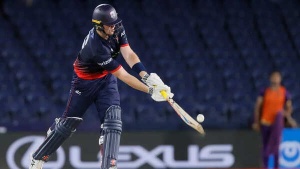The International Cricket Council (ICC) has announced revisions to the Playing Conditions for Twenty20 Internationals, with the most significant adjustment affecting PowerPlay calculations. Specifically, the duration of the PowerPlay will now be calculated to the nearest ball, offering more precision than the previous method of rounding to the nearest over.

Under existing regulations, the initial six overs constitute the PowerPlay, representing roughly 30% of a standard 20-over innings. When innings are shortened, rounding to the nearest over can lead to disproportionate alterations to this crucial phase of the game.
When the number of overs for the batting team is reduced, the number of Powerplay overs will be adjusted according to the table below. Note that this applies to both the 1st and 2nd innings of the match.
| Match reduced (overs) | Powerplay overs |
|---|---|
| 5 | 1.3 |
| 6 | 1.5 |
| 7 | 2.1 |
| 8 | 2.2 |
| 9 | 2.4 |
| 10 | 3 |
| 11 | 3.2 |
| 12 | 3.4 |
| 13 | 3.5 |
| 14 | 4.1 |
| 15 | 4.3 |
| 16 | 4.5 |
| 17 | 5.1 |
| 18 | 5.2 |
| 19 | 5.4 |
For example, previously an 8-over innings would have two PowerPlay overs. Now it will end after 2.2 overs, maintaining a closer proportion to the standard 30%.
The ICC stated, "This table has been used in the T20 Blast in England for many years, where ending a powerplay midway through an over has caused no difficulty for players or officials. It has now been accepted by the ICC Men's Cricket Committee as the preferred method moving forward. In the 8 over example above, the umpire will make the signal after 2 balls of the 3rd over, at which point three further fielders are able to drop back from within the circle."
The ICC had previously directed that concussion replacements in Men's T20I matches must be identified and named before the match begins. This aims to level the playing field by eliminating any home-team advantage stemming from a larger pool of available players. The ideal scenario involves nominating the following concussion replacements to the match referee prior to the match:
The ICC acknowledged that Associate Member teams playing T20I matches may struggle to identify five specific concussion replacement players for each match, particularly when playing overseas. The system adopted for Associate Member T20Is will address this issue.
Teams can nominate a batter as the replacement wicketkeeper. However, the referee may stipulate that the nominated batter must keep wicket if used as the replacement. Alternatively, the referee may allow another player in the starting XI to keep wicket, but that is at their discretion. The intent is like-for-like replacement, not gaining an advantage with another batter.
Teams can nominate the same player for multiple categories. For example, if an all-rounder nominated for multiple positions replaces a batter, the referee may restrict them from bowling. The concussion replacement is not restricted to the playing squad.
The overriding principle of like-for-like concussion replacement remains, and the referee will manage replacements based on the circumstances. The referee retains the discretion to determine if a replacement player closely matches the injured player.
Examples:
Under exceptional circumstances, the match referee may consider a replacement player who is outside of the nominated replacements submitted by the team for the match.
The ICC states that using any substance, including saliva, to alter the condition of the ball will result in a mandatory ball replacement. This new clause can prevent the ball from being automatically changed in circumstances where a team deliberately applies saliva to get it replaced.
These changes apply only to the Men's playing conditions. Women's playing conditions will be updated in October. The new playing conditions will be effective from July 10, 2025.
Newer articles
Older articles
 Smith Eyes Grenada Test Return After Injury Recovery
Smith Eyes Grenada Test Return After Injury Recovery
 Google Maps Boosts Navigation Precision with Fused Orientation Provider Update
Google Maps Boosts Navigation Precision with Fused Orientation Provider Update
 Earth Sciences Minister Rijiju Expresses Frustration Over Atos Supercomputer Delay, Jeopardizing Weather Forecast Upgrades
Earth Sciences Minister Rijiju Expresses Frustration Over Atos Supercomputer Delay, Jeopardizing Weather Forecast Upgrades
 Washington Freedom Snatch Last-Ball Win Over Knight Riders in MLC Thriller; Playoff Hopes Soar
Washington Freedom Snatch Last-Ball Win Over Knight Riders in MLC Thriller; Playoff Hopes Soar
 East Africa Rift: Mantle Upwelling Drives Birth of New Ocean, Study Finds
East Africa Rift: Mantle Upwelling Drives Birth of New Ocean, Study Finds
 Colon Cancer: Don't Ignore These 5 Subtle Warning Signs
Colon Cancer: Don't Ignore These 5 Subtle Warning Signs
 Prasidh Krishna Vows to Sharpen Bowling After Costly Leeds Performance
Prasidh Krishna Vows to Sharpen Bowling After Costly Leeds Performance
 Gavaskar Urges India to Replace Thakur with Yadav for Second Test Against England
Gavaskar Urges India to Replace Thakur with Yadav for Second Test Against England
 Rishabh Pant's Unconventional Batting Style Is Revolutionizing Cricket, Says Greg Chappell
Rishabh Pant's Unconventional Batting Style Is Revolutionizing Cricket, Says Greg Chappell
 Vitamin B12 Deficiency: Cardiologist Explains Symptoms, Sources, and Why You're Always Tired
Vitamin B12 Deficiency: Cardiologist Explains Symptoms, Sources, and Why You're Always Tired